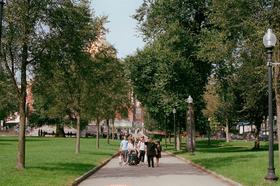The Catch-22 of Community College Graduation Rates
President Obama has shined a significant spotlight on America’s college graduation rates throughout his administration, and community colleges are feeling the pressure.
- According to the Hechinger Report, fewer than one out of five students at community colleges obtain their desired degree in three years or less.
- A recent study published by the American Institutes for Research (AIR) paints a similarly grim picture by indicating that high college dropout rates cost both state and federal governments billions of dollars yearly.
- However, do these numbers accurately depict what is happening in community colleges and four-year institutions nationwide?
- This article will explore the many reasons for high dropout rates, including flaws in how such data is collected.
What the Numbers Show
.png)
As shown in the graph above, National Center for Education Statistics data shows that only 13 percent of community college students graduate in two years.
- Within three years, approximately 22 percent of students graduate; within four years, the rate stands at 28 percent.
- Further data from AIR shows that only about 60% of college students graduate from four-year colleges and universities within six years.
- AIR vice president Mark Schneider claims that state and federal governments spend more than $9 billion annually on these students.
- Yet, all that funding fails to produce a college graduate who could bring those years of education to the country's workforce.
- While the AIR numbers are related explicitly to enrollment at four-year institutions, they do not bode well for community colleges, particularly when President Obama is trying to raise graduation rates at two-year schools.
What the Numbers Don’t Show
But are these statistics accurate?
- For educators and others who delve further into the facts and figures, many students may benefit more from community college than the initial data might indicate.
- For example, an article in the Patriot Ledger reports that some community college "dropouts" might include students who transfer to a four-year institution before earning their associate's degree.
- While they did not finish their education at the community college, these students moved on to bigger goals for their education and future.
- One-fourth of all college students who begin at a community college go on to a four-year institution; of those, 60 percent graduate with their bachelor’s degree.
- Yet in many reports, these students are lumped into the “dropout” category, thus making community college graduation rates look worse than they are.
A report in Tufts Daily states that other students do not finish their degrees in the timeframe set by studies, which tends to be within five years.
- Students might begin their education, then leave to tend to family issues or enter the workforce or the military, only to return many years later to graduate with their degree.
- These students may finish their degrees, but since they took more time than studies allow, they are classified as college dropouts.
Another report by the New American Foundation explores the specific needs of community college students and relates those to dismal graduation rates.
- The report explains that many high school graduates from low-income families or are first-generation college-goers may find community college the best option for them.
- However, life circumstances for these demographics, including financial constraints, transportation, and childcare needs, can hinder goals to finish the educational process and obtain a degree in a traditional timeframe.
- Therefore, many of the students who show up in reports as “dropouts” did not leave school because they wanted to, instead, they were compelled to by some uncontrollable life event.
- While it is difficult to determine the exact number of students who fall into this category, it is sure to be a large portion of the total number of students who do not complete their two-year degree.
- The American Community College Association contends that if this and other factors were considered, graduation rates for two-year institutions would be closer to 40 percent.
The Misconception About "Students"
Although some studies assume that postsecondary students are typically traditional students who attend college immediately after high school, this assumption does not hold true, especially in community colleges.
- Many students are professionals needing additional education to compete in the workforce.
- For example, a real estate agent who needs to brush up on her math might take one or two math classes at a local community college.
- These kinds of students do not fit the traditional mold and may not require the conventional educational model of a set number of years of schooling and a degree to succeed in their field. Yet, they may be classified as dropouts because they don’t acquire a degree.
- Students who attend community college right after high school often need remedial assistance to prepare them for the rigors of postsecondary schooling.
According to the Center on International Education Benchmarking, 42 percent of community college first-year students need remediation to succeed. If academic support is unavailable, these students may slip through the cracks and add to the dropout statistics.
- However, even when support is available, students who take remedial classes are far less likely to graduate – after five years, only about 25 percent obtain a degree.
- However, many schools have implemented programs seeking to retain and see students through graduation.
- For example, at Northern Virginia Community College, students must maintain a continuous relationship with counselors, ensuring they receive the support and guidance they need to succeed in college.
- Other colleges have implemented transfer student programs that guide students through transferring to a four-year institution.
Some schools have early alert referrals, in which professors who see a student’s grades slipping refer the student to academic support and advisement to get help getting back on track.
- Yet other institutions require coursework for freshmen to familiarize them with appropriate ways to study and maintain good grades.
- With these and many other nationwide programs, we may begin to see graduation rates rise.
- While there is room for improvement in the community college completion rate, the current statistics may be misleading regarding just how successful these institutions are.
- Studies claiming low graduation rates should be taken with a grain of salt.
- Yet, with more focus placed on community colleges by the current administration, it is worthwhile to take the time to explore the benefits of community college and how the educational system can improve to help retain students through to graduation.
Conclusion
Community colleges face unique challenges in improving graduation rates, often due to misconceptions about student demographics and the complexities of their educational journeys. While statistics may paint a grim picture, understanding the nuances—such as students transferring to four-year institutions or returning after life interruptions—can provide a more accurate view of community college success. By addressing these challenges through innovative programs and support services, community colleges can enhance student retention and completion rates, ultimately contributing to a more educated and skilled workforce. As institutions continue to evolve and adapt, the potential for increased graduation rates and long-term economic benefits for both individuals and society becomes increasingly promising.
Questions? Contact us on Facebook and Instagram. @communitycollegereview
#CommunityCollege, #GraduationRates, #HigherEducation, #CollegeCompletion, #StudentSuccess















